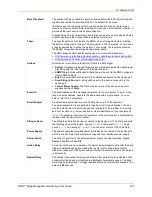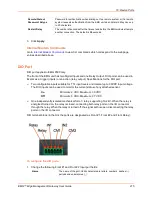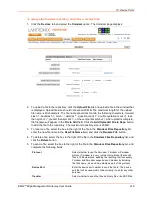
10: Device Ports
EMG™ Edge Management Gateway User Guide
204
Device Ports - Logging and Events
The EMG products support port buffering of the data on the system's device ports as well as
notification of receiving data on a device port. Port logging is disabled by default. You can enable
more than one type of logging (local, NFS file, token and data detection, SD card, or USB port) at
a time. The buffer containing device port data is cleared when any type of logging is enabled.
Local Logging
If local logging is enabled, each device port stores 256 Kbytes (approximately 400 screens) of I/O
data in a true first-in, first-out (FIFO) buffer. You may view this data (in ASCII format) at the CLI
with the
show locallog
Devices > Device Ports - Logging & Events
Buffered data is normally stored in RAM and is lost in the event of a power failure if it is not logged
using an NFS mount solution. If the buffer data overflows the buffer capacity, only the oldest data
is lost, and only in the amount of overrun (not in large blocks of memory).
NFS File Logging
Data can be logged to a file on a remote NFS server. Data logged locally to the EMG is limited to
256 Kbytes and may be lost in the event of a power loss. Data logged to a file on an NFS server
does not have these limitations. The system administrator can define the directory for saving
logged data on a port-by-port basis and configure file size and number of files per port.
The directory path must be the local directory for one of the NFS mounts. For each logging file,
once the file size reaches the maximum, a new file opens for logging. Once the number of files
reaches the maximum, the oldest file is overwritten. The file naming convention is: <Device Port
Number>_<Device Port Name>_<File number>.log.
Examples:
02_Port-2_1.log
02_Port-2_2.log
02_Port-2_3.log
02_Port-2_4.log
02_Port-2_5.log
USB and SD Card Logging
Data can be logged to a USB flash drive or the SD card slot on the front of the EMG unit and
properly mounted. Data logged locally to the EMG is limited to 256 Kbytes and may be lost in the
event of a power loss. Data logged to a USB flash drive or SD card does not have these
limitations. The system administrator can define the file size and number of files per port. For each
logging file, once the file size reaches the maximum, a new file opens for logging. Once the
number of files reaches the maximum, the oldest file is overwritten. The file naming convention is:
<Device Port Number>_<Device Port Name>_<File number>.log
Examples:
02_Port-2_1.log
02_Port-2_2.log
02_Port-2_3.log
02_Port-2_4.log
02_Port-2_5.log
Summary of Contents for EMG Series
Page 100: ...7 Networking EMG Edge Management Gateway User Guide 100 Figure 7 5 Network Wireless Settings...
Page 353: ...15 Maintenance EMG Edge Management Gateway User Guide 353 Figure 15 12 About EMG...
Page 474: ...EMG Edge Management Gateway User Guide 474 Figure E 3 EU Declaration of Conformity...
Page 475: ...EMG Edge Management Gateway User Guide 475 Figure E 4 EU Declaration of Conformity continued...
















































